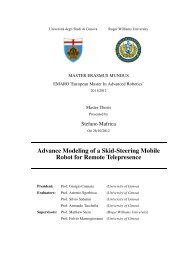RWRCCL - Roger Williams University
RWRCCL - Roger Williams University
RWRCCL - Roger Williams University
You also want an ePaper? Increase the reach of your titles
YUMPU automatically turns print PDFs into web optimized ePapers that Google loves.
performing no servo control. Although both modules can be<br />
resident in the kernel, RealTime Linux by default allows only<br />
one real-time process at a time. There are third-party<br />
preemptive scheduling modules available, but we did not<br />
experiment with these. It is therefore not possible to run the<br />
simulator and the robot controller simultaneously. After some<br />
porting of the simple graphics to current X-windows libraries,<br />
all of the upper-level functions of robotsim are unchanged.<br />
B. Teachdemo<br />
An interactive program teachdemo simulates the teach<br />
pendant and allows live, command-line control of the robot.<br />
The teachdemo program compiled and functioned in the<br />
<strong>RWRCCL</strong> system without modification. However, the actual<br />
teach pendant was connected via serial line to the LSI-11<br />
processor, so this connection required modification. We rewired<br />
the teach pendant through the control chassis to the 9-<br />
pin serial port of the Linux machine (/dev/ttys0). The teach<br />
pendant sends straightforward two-byte packets on a 9600<br />
baud serial line when buttons are pressed. Similarly, two-byte<br />
packets can be sent to the teach pendant to set the state of<br />
LEDs or cause a message to appear on the single-line display.<br />
Currently, we can exchange command packets with the teach<br />
pendant asynchronously. To date we have not integrated<br />
serial port communication into the teachdemo program, but<br />
expect this will be straightforward.<br />
C. Calibration<br />
For reasons not entirely clear to us we are unable to use<br />
the TRC004 A/D converters to read the joint potentiometers.<br />
It may be we have damaged our TRC004 card; because<br />
analog signals presented to the A/D appear correct when<br />
measured by hand. We have not implemented the dynamic<br />
calibration function of the PUMA because of this limitation.<br />
This function normally allows the PUMA to calibrate itself<br />
from any position in its workspace (the sole function of the<br />
potentiometers). We instead rely on manual calibration,<br />
where we move the robot to a known position by hand and<br />
load the encoders with corresponding values using the<br />
primecal program.<br />
D. Root users<br />
The TRC006 card resides in reserved I/O space of the<br />
Linux operating system. Since programs must read and write<br />
to these ports, currently all <strong>RWRCCL</strong> program must be run as<br />
root (superuser). There are probably a workarounds for this,<br />
but we have not explored these. We have no qualms with<br />
allowing a few users to log in as root to run programs, but<br />
other institutions may not be as casual.<br />
VI. CONCLUSION<br />
PUMA robots can still frequently be found in academic<br />
labs. A shoestring budget is one reason we (and perhaps<br />
others) are still working with PUMA robots, these often being<br />
donated and/or used equipment. We imagine researchers like<br />
ourselves are frequently searching for the least expensive way<br />
to make a robot operational.<br />
The solution described here is suitably cost effective,<br />
especially if one already has an old PUMA robot. It requires<br />
purchasing only the Mark V Automation TRC004/006 cards<br />
(about $1200 at the time of writing) and one decent<br />
performance PC (
















